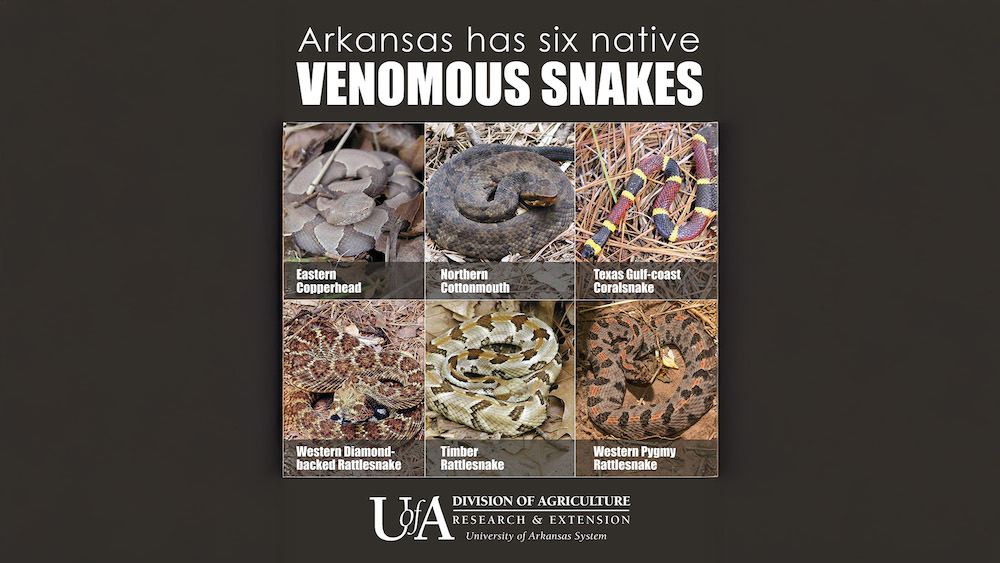LITTLE ROCK — Whether enjoying the Natural State on land or by water this summer, it’s important to keep an eye out for Arkansas’ six native venomous snake species — and to educate yourself on how to avoid them.
By Rebekah Hall
U of A System Division of Agriculture
Shannon Caldwell, 4-H Center program director for the University of Arkansas System Division of Agriculture, said learning about the state’s 39 native snake species can help Arkansans better enjoy their time outside.
“The best thing to do is learn about these snakes because the more you learn, the better you can understand which are venomous and which are not,” Caldwell said. “If you know that snakes don’t want anything to do with you, that’s going to cut down on your fear response. But if you don’t educate yourself, and you feel like every snake is potentially harmful, then that cuts into your enjoyment of being outside.”
Of the 39 native snake species, the six venomous species include the Eastern Copperhead, Northern Cottonmouth, Western Diamond-backed Rattlesnake, Western Pygmy Rattlesnake, Timber Rattlesnake and Texas Coral snake. For a guide on identifying these species and more information about native snakes, visit the Cooperative Extension Service’s Snakes of Arkansas web page.
Caldwell also recommends the Herps of Arkansas website, which offers an identification guide for amphibians and reptiles in the state, including both harmless and venomous snakes. When hiking or traveling on Arkansas’ many waterways, awareness is key.
“Snakes are going to be where they can find food and shelter,” Caldwell said. “If there’s going to be rodents in an area, there’s potentially going to be things that want to eat rodents there, snakes included.”
Take the following steps to practice snake safety:
· Make sure your path is well lit and has little ground cover, where snakes may be easily seen. If walking at night, use a light source to brighten the path.
· Never step over logs or other obstacles unless you can see the other side.
· Always look with caution. “Don’t just blindly stick your hand somewhere,” Caldwell said. “Wear gloves to protect yourself or take a stick or pole to help you flip something over, so you’re not putting yourself at risk.”
· Make noise and carefully watch where you step.
· Wear close-toed shoes or boots. Many snakebites result from going barefoot or wearing sandals outside.
Caldwell said most snake bites result from accidents — such as stepping on a camouflaged snake — or from people trying to handle a snake.
“When you encounter a snake, the best response is to avoid it,” Caldwell said. “Try to take a different path, especially if you don’t know what type of snake it is. It’s probably headed in a certain direction, so let it go and do your best to stay out of its way.”
Caldwell recommended staying on the established path, if walking on a trail, as the path is “there for a reason, so you can enjoy those settings in a more controlled way.” She said this can also help with avoiding other animals, insects and arachnids, including ticks.
If enjoying the water in a canoe, kayak or tube, “you might have less control over your path, so it’s important to learn about your surroundings,” Caldwell said. “Try to avoid areas where snakes like to take shelter, such as the trees along the shore, or places where it would be convenient for something to hide. While looking ahead to avoid water obstacles, watch for overhanging limbs and maneuver carefully around them.”
Snakebite treatment
If bitten by a venomous snake — or if you’re unsure of the type of snake — seek immediate medical care.
“Don’t try to bring the snake with you to the hospital,” Caldwell said. “Most of us have a camera in our pocket, so try to get a picture of it if you can, but don’t feel like you have to pause care to identify the snake. Once you get to the medical facility, they will be able to look at the wound and provide the right care.”
· Remain calm, so as not to increase blood circulation and spread venom more quickly through the body.
· Remove rings, watches, shoes and other restrictive clothing near the bite.
· Call ahead, if possible, to alert medics or call your local emergency medical facility if you need transportation.
· Keep the bite area immobilized as much as possible.
· Do not apply ice, do not make cuts, and do not apply a tourniquet.
· Clean the bite with soap and water. Cover it loosely with a clean, dry bandage.
Caldwell said that if you are bitten by a snake that you’re sure is nonvenomous, treat the bite as you would any other bite, scrape or cut.
If hiking in a more remote area, Caldwell said it’s important to prepare for emergencies by taking a wilderness first aid course.
“If you’re going to be spending time in our beautiful state away from close medical care, then you need to make it a priority to take a wilderness first-aid class so that you have the knowledge of what to do,” Caldwell said. “The regular first aid that many of us learn is designed with the expectation that you have access to close medical care. Wilderness first aid is unique, because it centers on the reality of being far away from a doctor or hospital. It’s all about education.”
All native snakes, including venomous snakes, are protected by law. It is illegal to kill snakes in Arkansas unless they pose an immediate threat to people, pets or property. The Arkansas Game and Fish Commission enforces regulations which prohibit killing nongame species.
Wilderness First Aid courses are available through the American Red Cross. The C.A. Vines Arkansas 4-H Center also hosts a Wilderness First Aid course through the National Outdoor Leadership School every two years.
To report nuisance wildlife, such as snakes in your home or yard, call the Arkansas Game and Fish Commission’s nuisance wildlife hotline at 833-345-0315 and visit agfc.com/education/nuisance-wildlife.
To learn about extension programs in Arkansas, contact your local Cooperative Extension Service agent or visit www.uaex.uada.edu. Follow us on X and Instagram at @AR_Extension. To learn more about Division of Agriculture research, visit the Arkansas Agricultural Experiment Station website: https://aaes.uada.edu. Follow on X at @ArkAgResearch. To learn more about the Division of Agriculture, visit https://uada.edu/. Follow us on X at @AgInArk.
About the Division of Agriculture
The University of Arkansas System Division of Agriculture’s mission is to strengthen agriculture, communities, and families by connecting trusted research to the adoption of best practices. Through the Agricultural Experiment Station and the Cooperative Extension Service, the Division of Agriculture conducts research and extension work within the nation’s historic land grant education system.
The Division of Agriculture is one of 20 entities within the University of Arkansas System. It has offices in all 75 counties in Arkansas and faculty on three campuses.
Pursuant to 7 CFR § 15.3, the University of Arkansas System Division of Agriculture offers all its Extension and Research programs and services (including employment) without regard to race, color, sex, national origin, religion, age, disability, marital or veteran status, genetic information, sexual preference, pregnancy or any other legally protected status, and is an equal opportunity institution.






